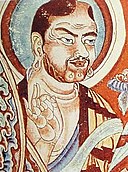Fișier:Central Asian Buddhist Monks.jpeg
Central_Asian_Buddhist_Monks.jpeg (470 × 591 pixeli, mărime fișier: 173 KB, tip MIME: image/jpeg)
Istoricul fișierului
Apăsați pe Data și ora pentru a vedea versiunea trimisă atunci.
| Data și ora | Miniatură | Dimensiuni | Utilizator | Comentariu | |
|---|---|---|---|---|---|
| actuală | 27 martie 2005 15:25 |  | 470x591 (173 KB) | Beta m common | 9th century fresco from Bezeklilk, Tarim Basin. {{PD-art}} |
Utilizarea fișierului
Următoarele pagini conțin această imagine:
Utilizarea globală a fișierului
Următoarele alte proiecte wiki folosesc acest fișier:
- Utilizare la ar.wikipedia.org
- Utilizare la ast.wikipedia.org
- Utilizare la az.wikipedia.org
- Utilizare la ba.wikipedia.org
- Utilizare la bg.wikipedia.org
- Utilizare la bjn.wikipedia.org
- Utilizare la bn.wikipedia.org
- Utilizare la bs.wikipedia.org
- Utilizare la bxr.wikipedia.org
- Utilizare la ca.wikipedia.org
- Utilizare la cs.wikipedia.org
- Utilizare la cv.wikipedia.org
- Utilizare la da.wikipedia.org
- Utilizare la de.wikipedia.org
- Utilizare la de.wikivoyage.org
- Utilizare la el.wikipedia.org
- Utilizare la en.wikipedia.org
Vizualizați utilizările globale ale acestui fișier.


